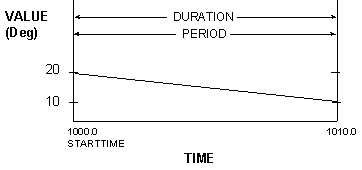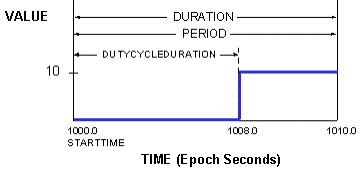Completing a Cycle
Once you have specified a
STARTVALUE and
ENDVALUE, you can define the manner in which the transformation value changes over a cycle. There are several ways to define the articulation cycle.
- Linear
- Step
- Nonlinear
- Deadband
Defining a Linear Cycle
By default, the transformation value varies linearly from the
STARTVALUE to the
ENDVALUE over a cycle.
Articulation keyword showing a linear cycle
STARTTIME 1000.0
DURATION 10.0
DEADBANDDURATION 0.0
ACCELDURATION 0.0
DECELDURATION 0.0
DUTYCYCLEDELTA 0.0
PERIOD 0.0
ARTICULATION tailRudder
TRANSFORMATION tailRudderZRotation
STARTVALUE 20.0
ENDVALUE 10.0

Graph illustrating Linear cycle concept
Defining a Step Cycle
To define a step cycle, set the
DUTYCYCLEDELTA greater than 0.0. The
DUTYCYCLEDELTA is an offset from the beginning of a cycle where the transition from
STARTVALUE to
ENDVALUE will occur.
Articulation keyword showing a step cycle
NEW_ARTICULATION
STARTTIME 1000.0
DURATION 10.0
DEADBANDDURATION 0.0
ACCELDURATION 0.0
DECELDURATION 0.0
DUTYCYCLEDELTA 8.0
PERIOD 0.0
ARTICULATION Explosion
TRANSFORMATION ExplosionUniformScale
STARTVALUE 0.0
ENDVALUE 10.0

Graph illustrating the step cycle concept
Defining a Nonlinear Cycle
To define a nonlinear cycle, set the
ACCELDURATION or
DECELDURATION value to be greater than 0.0. The value of
ACCELDURATION plus
DECELDURATION must be less than or equal to the PERIOD.
From the [beginning of a PERIOD] to the
[beginning of a PERIOD + ACCELDURATION], the value changes under constant acceleration. From the
[beginning of a PERIOD + ACCELDURATION] to the
[end of the PERIOD - DECELDURATION], the value changes under zero acceleration. From the
[end of the PERIOD - DECELDURATION] to the
[end of the PERIOD], the value changes under constant deceleration.
If the DUTYCYCLEDELTA is greater than 0.0, ACCELDURATION and DECELDURATION should be set to 0.0 and vice versa.
Articulation keyword showing a nonlinear cycle
NEW_ARTICULATION
STARTTIME 1000.0
DURATION 32.0
DEADBANDDURATION 0.0
ACCELDURATION 4.2
DECELDURATION 3.6
DUTYCYCLEDELTA 0.0
PERIOD 0.0
ARTICULATION SatelliteSlew
TRANSFORMATION SatelliteSlewXRotation
STARTVALUE 10.0
ENDVALUE 33.7

Graph illustrating the nonlinear cycle concept
Using a DEADBAND Parameter to Modify a Cycle
You can use a
DEADBANDDURATION parameter to lessen the time it takes to move from
STARTVALUE to
ENDVALUE. If a
DEADBANDDURATION parameter is specified in the articulation keyword, the
ENDVALUE is reached at
[end of a PERIOD - DEADBANDDURATION]. From the
[end of a PERIOD - DEADBANDDURATION] to the
[end of PERIOD], no movement occurs. The
DEADBANDDURATION parameter is used in conjunction with linear, step and nonlinear cycles.
Articulation showing
DEADBANDDURATION> specified for a linear cycle
NEW_ARTICULATION
STARTTIME 1000.0
DURATION 32.0
DEADBANDDURATION 10.0
ACCELDURATION 0.0
DECELDURATION 0.0
DUTYCYCLEDELTA 0.0
PERIOD 0.0
ARTICULATION SatelliteSlew
TRANSFORMATION SatelliteSlewXRotation
STARTVALUE 5.0
ENDVALUE 33.7

Articulation showing DEADBANDDURATION specified for a linear cycle
Defining a Complex Cycle
If the ground radar model file contained the fragment shown in the model file example, the articulation file would contain the fragment shown in the articulation file example. In the example, the antenna will sweep back and forth 50 times because the
PERIOD is 20.0 seconds and the
DURATION is 1000.0 seconds.
Model file referring to a complex articulation cycle
Component RadarBody
Refer
Articulation antennaSweep
zRotate sweepAroundZAxis -45.0 -45.0 45.0
EndArticulation
Component Antenna
EndRefer
EndComponent
Articulation file defining a complex articulation cycle
NEW_ARTICULATION
STARTTIME 200.0
DURATION 1000.0
DEADBANDDURATION 10.0
ACCELDURATION 0.0
DECELDURATION 0.0
DUTYCYCLEDELTA 0.0
PERIOD 20.0
ARTICULATION antennaSweep
TRANSFORMATION sweepAroundZAxis
STARTVALUE -45.0
ENDVALUE 45.0
NEW_ARTICULATION
STARTTIME 210.0
DURATION 1000.0
DEADBANDDURATION 10.0
ACCELDURATION 0.0
DECELDURATION 0.0
DUTYCYCLEDELTA 0.0
PERIOD 20.0
ARTICULATION antennaSweep
TRANSFORMATION sweepAroundZAxis
STARTVALUE 45.0
ENDVALUE -45.0

Diagram illustrating a complex cycle
In the graph shown, two articulations with the same ARTICULATION name and the same TRANSFORMATION name parameters overlap. When this occurs, the value from the articulation that is not in the deadband period is used. If more than one articulation is not in the deadband period at the same time, a value from one of those articulations will be used, but which one is not guaranteed.